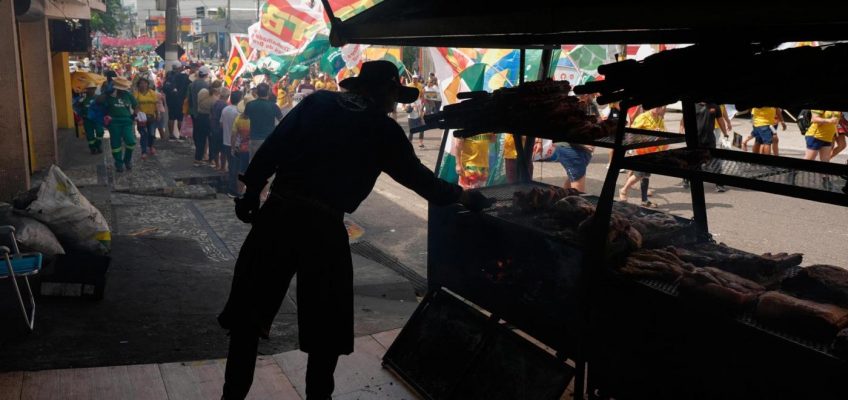By MELINA WALLING and JOSHUA A. BICKEL
BELEM, Brazil (AP) — With a spotlight on the Brazilian Amazon, where agriculture drives a significant chunk of deforestation and planet-warming emissions, many of the activists, scientists and government leaders at United Nations climate talks have a beef. They want more to be done to transform the world’s food system.
Protesters gathered outside a new space at the talks, the industry-sponsored “Agrizone,” to call for a transition toward a more grassroots food system, even as hundreds of lobbyists for big agriculture companies are attending the talks.
Demonstrators protest against big agribusiness near the agriZONE during the COP30 U.N. Climate Summit, Monday, Nov. 10, 2025, in Belem, Brazil. (AP Photo/Joshua A. Bickel)
Though agriculture contributes about a third of Earth-warming emissions worldwide, most of the money dedicated to fighting climate change goes to causes other than agriculture, according to the U.N.’s Food and Agriculture Organization.
The FAO didn’t offer any single answer as to how that spending should be shifted, or on what foods people should be eating.
“All the countries are coming together. I don’t think we can impose on them one specific worldview,” said Kaveh Zahedi, director of the organization’s Office of Climate Change, Biodiversity and Environment.
Related Articles
UN General Assembly chief says curbing climate change would make world more peaceful and safer
Nations and environmental groups slam proposals at UN climate talks, calling them too weak
A drying-up Rio Grande basin threatens water security on both sides of the border
Trump administration announces plan for new oil drilling off the coasts of California and Florida
Trump administration revives rollbacks of species protections from first term
Research has generally shown that a plant-based diet can be better for health and the planet. But many people in poverty around the world who are hardest hit by climate change depend on animal sources of protein for survival. People in higher-income countries have more options for a healthy diet without meat. But those people still tend to contribute more to climate change with their dietary choices.
“We have to be very, very aware and conscious of those nuances, those differences that exist,” Zahedi said.
An alternative universe at COP for agriculture
When world leaders gather every year to try to address climate change, they spend much of their time in a giant, artificial world that typically gets built up just for the conference.
One corner of COP30, as this year’s conference is known, featured the alternative universe of AgriZone, where visitors could step into a world of immersive videos and exhibits with live plants and food products. Those included a research farm that Brazilian national agricultural research corporation Embrapa built to showcase what they call low-carbon farming methods for raising cattle, and growing crops like corn and soy as well as ways to integrate cover crops like legumes or trees like teak and eucalyptus.
A cutout cow stands in a crop research field at the AgriZone near the COP30 U.N. Climate Summit, Tuesday, Nov. 18, 2025, in Belem, Brazil. (AP Photo/Joshua A. Bickel)
Ana Euler, executive director of innovation, business and technology transfer at Embrapa, said her industry can offer solutions needed especially in the Global South where climate change is hitting hardest.
“We need to be part of the discussions in terms of climate funds,” Euler said. “We researchers, we speak loud, but nobody listens.”
AgriZone was averaging about 2,000 visitors a day during COP30’s two-week run, said Gabriel Faria, an Embrapa spokesman. That included tours for Queen Mary of Denmark, COP President André Corrêa do Lago and other Brazilian state and local officials.
But while the AgriZone seeks to spread a message of lower-carbon agriculture possibilities, industrial agriculture retains a big influence at the climate talks. The climate-focused news site DeSmog reported that more than 300 industrial agriculture lobbyists are attending COP30.
A man cooks chicken in Itacoa Miri, Brazil, Tuesday, Nov. 18, 2025. (AP Photo/Fernando Llano)
In the face of big industry, some call for a voice for smallholder farmers
On a humid evening at COP30’s opening, a group of activists gathered on the grassy center of a busy roundabout in front of the AgriZone to call for food systems that prioritize good working conditions and sustainability and for industry lobbyists to not be allowed at the talks.
Those with the most sway are “not the smallholder food producers, … not the peasants, and … definitely not all these people in the Global South that are experiencing the brunt of the crisis,” said Pang Delgra, an activist with the Asian People’s Movement on Debt and Development who was among the protesters. “It’s this industrial agriculture and corporate lobbyists that are shifting the narrative inside COPs.”
Workers take a break while maintaining a research field of cassava crops at the AgriZone near the COP30 U.N. Climate Summit, Tuesday, Nov. 18, 2025, in Belem, Brazil. (AP Photo/Joshua A. Bickel)
As Indigenous people pushed to be heard at a COP that was supposed to be about them, some also called for countries to honor their knowledge of land stewardship.
“We have to decolonize our thoughts. It’s not just about changing to a different food,” said Sara Omi, from the Embera people of Panama and president of the Coordination of Territorial Leaders of the Mesoamerican Alliance of Peoples and Forests.
“The agro-industrial systems are not the solution,” she added. “The solution is our own ancestral systems that we maintain as Indigenous peoples.”
Follow Melina Walling on X @MelinaWalling and Bluesky @melinawalling.bsky.social. Follow Joshua A. Bickel on Instagram, Bluesky and X @joshuabickel.
The Associated Press’ climate and environmental coverage receives financial support from multiple private foundations. AP is solely responsible for all content. Find AP’s standards for working with philanthropies, a list of supporters and funded coverage areas at AP.org.




